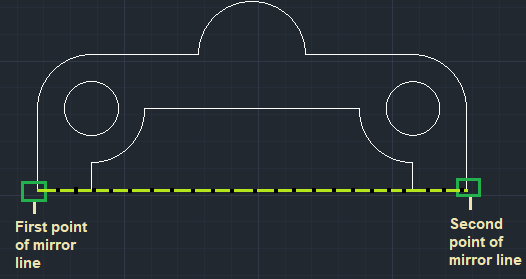Mastering Object Offset and Mirroring in AutoCAD: A Comprehensive Guide to Precision Design Techniques

Introduction: AutoCAD, a leading computer-aided design (CAD) software, empowers architects, engineers, designers, and drafters to create precise and intricate designs with efficiency and accuracy. Among its array of powerful tools and features, the ability to offset and mirror objects plays a crucial role in design workflows. Offset and mirroring operations allow users to duplicate, mirror, and modify geometry, enabling them to create symmetrical layouts, replicate design elements, and streamline design iterations. In this comprehensive guide, we will explore the techniques, functionalities, and best practices for offsetting and mirroring objects in AutoCAD, empowering users to unlock the full potential of these tools and achieve their design goals with precision and creativity.
Understanding Object Offset and Mirroring: In AutoCAD, object offset and mirroring are fundamental operations that involve duplicating and reflecting geometry about a specified axis or line. These operations are commonly used to create symmetrical designs, replicate patterns, and modify existing geometry without the need for manual drawing or construction. Offsetting involves creating a parallel copy of an object at a specified distance, while mirroring involves creating a mirror image of an object across a designated mirror line or axis. Both operations offer versatile tools for manipulating and modifying geometry in the drawing environment.
Key Concepts of Object Offset and Mirroring: Before delving into the process of offsetting and mirroring objects in AutoCAD, it’s essential to understand some key concepts that underpin these operations:
- Offset Distance: The offset distance refers to the distance by which the copied object is offset from the original object. Users can specify the offset distance numerically or graphically, allowing for precise control over the position and spacing of offset objects relative to the original geometry.
- Mirror Line: The mirror line is the axis or line about which the object is mirrored or reflected. Users can define the mirror line by selecting existing lines, construction lines, or drawing prompts, enabling flexibility in mirroring operations and allowing for symmetrical design layouts.
- Offset Direction: The offset direction determines the orientation of the offset copy relative to the original object. Users can specify the offset direction as inside, outside, or both sides of the original object, providing flexibility in offsetting operations and accommodating different design requirements and preferences.
- Symmetry and Repetition: Object offset and mirroring facilitate the creation of symmetrical designs and repetitive patterns by duplicating and reflecting geometry across specified axes or lines. These operations enable users to achieve balance, harmony, and consistency in design layouts, enhancing visual appeal and readability in drawings.
Basic Techniques for Object Offset and Mirroring: Using object offset and mirroring techniques in AutoCAD involves a series of steps that begin with selecting the desired objects and culminate in executing the offset or mirror command. Here’s a basic overview of the techniques for offsetting and mirroring objects:
- Selecting Objects: Start by selecting the objects you want to offset or mirror. Use selection methods such as window selection, crossing selection, or individual object selection to specify the objects to be manipulated.
- Offset Command: Execute the offset command by typing “OFFSET” in the command line or selecting it from the ribbon or toolbar. Specify the offset distance and direction, then click on the object you want to offset. AutoCAD will create a parallel copy of the object at the specified distance and direction.
- Mirror Command: Execute the mirror command by typing “MIRROR” in the command line or selecting it from the ribbon or toolbar. Specify the mirror line by selecting existing lines, construction lines, or drawing prompts. Then, select the objects you want to mirror. AutoCAD will create a mirror image of the selected objects across the specified mirror line.
- Editing and Refinement: After offsetting or mirroring objects, use editing and modification tools to refine and adjust the resulting geometry as needed. Modify object properties such as position, size, and orientation, and use editing commands such as trim, extend, fillet, or chamfer to further refine the design.
Advanced Techniques for Object Offset and Mirroring: While the basic techniques for object offset and mirroring suffice for most applications, mastering advanced techniques can enhance productivity, efficiency, and creativity in design workflows. Here are some advanced techniques and applications to consider:
- Offset and Mirror Arrays: Use array techniques to create multiple copies of objects with uniform spacing and orientation. Combine offset and mirroring operations with array commands such as “ARRAY” or “RECTANGULAR ARRAY” to create repetitive patterns, arrays, or layouts efficiently.
- Dynamic Offset and Mirroring: Explore dynamic offset and mirroring techniques to create parametric and adaptive designs that respond dynamically to changes in parameters or constraints. Use parametric constraints, dynamic blocks, or expressions to control offset distances, mirror lines, and other parameters dynamically, enabling designs to adapt to variations and updates automatically.
- Offset and Mirror Settings: Customize offset and mirror settings in AutoCAD to optimize performance and accuracy in design workflows. Adjust settings such as offset tolerance, object trimming, or mirror axis alignment to control the behavior and appearance of offset and mirrored objects, ensuring consistency and precision in design layouts.
- Offset and Mirror Macros: Develop custom macros or scripts to automate offset and mirroring tasks and streamline repetitive operations. Create custom commands or routines that combine offset and mirroring operations with other commands or functionalities, saving time and effort in design tasks and workflows.
Best Practices for Object Offset and Mirroring: To achieve optimal results when offsetting and mirroring objects in AutoCAD, consider the following best practices:
- Plan and Preview: Plan offset and mirroring operations in advance, and preview the results before executing the commands. Use object snaps, ortho mode, and preview options to visualize the outcome of offset and mirroring operations, ensuring accuracy and alignment with design intent.
- Maintain Object Integrity: Maintain the integrity of original objects when offsetting and mirroring by preserving object properties such as layer, color, linetype, and lineweight. Avoid exploding or modifying original objects unnecessarily, and use layers and object properties to manage and organize offset and mirrored objects effectively.
- Check for Overlaps and Intersections: Check for overlaps, intersections, or gaps between offset and mirrored objects, and resolve any discrepancies or conflicts to ensure geometric accuracy and completeness. Use editing and trimming tools to clean up overlapping geometry and ensure consistency and coherence in design layouts.
- Document and Review: Document offset and mirroring operations in drawings, and review them with stakeholders or collaborators to ensure clarity, accuracy, and alignment with project requirements. Use annotations, dimensions, and callouts to communicate design intent and specifications effectively, and solicit feedback or revisions as needed to refine the design.
Conclusion: Object offset and mirroring are powerful techniques in AutoCAD that enable users to duplicate, mirror, and modify geometry with precision and control. By mastering the techniques, functionalities, and best practices for offsetting and mirroring objects, users can enhance productivity, efficiency, and creativity in design workflows. Whether creating symmetrical layouts, replicating patterns, or modifying existing geometry, the ability to leverage offset and mirroring operations empowers users to realize their design visions with confidence and success. With practice, experimentation, and attention to detail, users can harness the full potential of offset and mirroring techniques to achieve outstanding results in today’s dynamic design environments.







